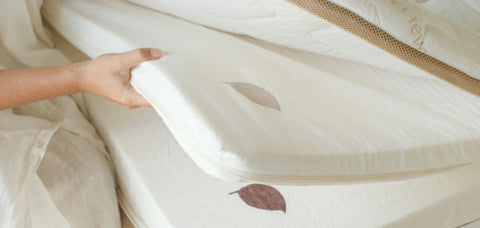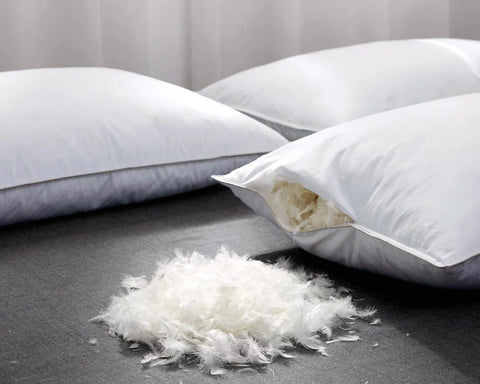
If you love the soft look of a fabric headboard but wake up sneezing or with itchy eyes, that question matters more than you might think. Fabric beds can trap dust mites, pet dander, and other allergen buildup, so good bedding care, breathable fabrics, and regular cleaning matter for indoor air quality and a symptom-free morning. This article gives clear steps and wise product choices, including the best Hypoallergenic Duvet Insert, so you can enjoy their upholstered bed’s style without the sniffles, clean, allergen-free sleep, and symptom-free mornings.
To reach that goal, Yumerest’s cloud-like fluffy duvets offer a breathable, easy-to-wash layer that works with washable covers, vacuuming, and simple mattress protection to help you keep dust and allergens under control while still sleeping in comfort.
Why Your Bed Could Be Causing Allergies

If you are waking up every morning with your eyes running, nose stuffed full, and itchy eyes, your mattress might be to blame. Pillows, bedding, and the mattress itself can quietly harbour dust mites, pet dander, mold, and pollen that can trigger allergies and sinus issues.
You cannot see most of these irritants, yet they sit deep in the mattress, cling to pillow fibers, or float in the air around your head. Do you notice symptoms only in the bedroom or worse on weekdays than on weekends? That pattern often points straight to bedroom allergens.
What are Common Allergens In Your Bed?
1. Dust Mites
Dust mites are microscopic creatures that thrive in warm, humid environments, making your mattress, pillows, and bedding the perfect breeding ground. They feed on dead skin cells and multiply fast, leaving behind waste particles that can trigger allergic reactions such as sneezing, congestion, and itchy eyes.
How to reduce potential dust mites:
-
Wash bedding in hot water (60°C or higher) every week
-
Use hypoallergenic mattress and pillow protectors
-
Vacuum your mattress and bed frame regularly
-
Keep humidity levels low with a dehumidifier
2. Pet Dander Trapped in Bedding
Even if your furry friend doesn’t sleep in your bed, pet dander, which is tiny skin flakes shed by cats and dogs, can easily cling to your bedding and pillows. Dander contains proteins that can irritate your immune system, potentially trigger allergic reactions, especially for those with asthma.
How to reduce pet dander:
-
Keep pets off the bed (or at least use a pet-friendly throw blanket you can wash frequently)
-
Wash bedding at least once a week
-
Use an air purifier with a HEPA filter to capture airborne dander
-
Bathe and groom pets regularly to minimise shedding
3. Mould and Mildew Caused By Damp Conditions
Mould and mildew thrive in damp, poorly ventilated environments, thus meaning your mattress, pillows, or even bed frame can be at risk. Exposure to mold spores can lead to nasal congestion, coughing, skin irritation, and potentially even more serious respiratory problems.
How to prevent mould and mildew in your bed:
-
Avoid sleeping on a mattress placed directly on the floor, as it restricts airflow
-
Use a breathable mattress protector to prevent moisture buildup
-
Keep your bedroom well-ventilated and consider using a dehumidifier
-
If your mattress ever gets wet, dry it out completely to prevent mould growth
4. Pollen That Sticks To Your Sheets
Pollen from outside can easily hitch a ride on your clothes, hair, and pets, in the spring and summer months, and if you wear these same clothes to lie on your bed, or do not wash your hair before lying down, you run the risk of transferring this pollen onto your pillows and bedding. If you’re sensitive to pollen, you might find your allergy symptoms flaring up more at night.
How to keep pollen out of your bed:
-
Shower before bed to rinse off pollen from your hair and skin
-
Keep windows closed during peak pollen season
-
Wash bedding more frequently, especially during spring and summer
-
Consider an air purifier to trap airborne pollen particles
5. Your Bed Frame Might Be Hiding More Than You Think
When thinking about allergens in the bedroom, most people focus on mattresses and bedding, but your bed frame could be making things worse, too. Upholstered bed frames and headboards, in particular, can trap dust, pet hair, and even mould spores over time, especially if they’re not cleaned regularly.
If you often wake up feeling congested or sneezy, your bed frame might be harbouring more than just stylish fabric.
How to keep your bed frame allergy-free:
-
If you have a fabric headboard or upholstered frame, give it a good vacuum every week using a brush attachment to remove dust and debris.
-
For wooden or metal frames, wipe them down regularly to prevent dust buildup, especially in corners and joints where allergens can collect.
-
If your bed frame is near a radiator or window, be mindful of moisture buildup, as dampness can lead to mould growth over time
Related Reading
- Best Hypoallergenic Duvet Insert
- Hypoallergenic Materials
- Is Microfiber Hypoallergenic
- Mattress Material
- Are Bamboo Mattresses Good
- Types of Pillows
- What Are Comforters Made of
- Why Does My Pillow Turn Yellow
- Best Pillow Case Material
- Are Down Comforters Bad for Allergies
- What Are Hypoallergenic Pillows Made of
Are Upholstered Beds Bad for Allergies

Contrary to common misconceptions, upholstered beds are not inherently bad for allergies. With the proper selection of hypoallergenic materials, regular cleaning and maintenance practices, and adequate bedroom hygiene, upholstered beds can be allergy-friendly and provide a comfortable sleep environment.
Remember that the overall cleanliness and allergen management in the bedroom play a significant role in minimising allergy triggers. If you have severe allergies, it is advisable to consult with an allergist for personalised recommendations.
Debunking Misconceptions
Myth: Upholstered Beds Harbour More Allergens
Fact: The belief that upholstered beds inherently harbour more allergens than other bed types is not entirely accurate. Allergens, such as dust mites, pet dander, or pollen, can be found in any type of bedding, including upholstered beds, traditional spring mattresses, or even wooden frames. The presence of allergens depends more on overall bedroom hygiene and maintenance practices rather than the bed type alone.
Myth: Upholstery Materials Trigger Allergic Reactions
Fact: The upholstery materials used in modern beds are designed to be hypoallergenic and resistant to dust mites and allergens. High-quality upholstered beds often incorporate allergen-resistant fabrics or treatments that help minimise the accumulation of dust, dander, and other common allergens.
Cleaning Experts Reveal GROSS Bacteria May Be Lurking In Your Upholstered Bed Frame
As important as it is to maintain your bedroom’s aesthetic style and the room’s flow of movement, it’s even more crucial to keep it clean. Given how much of our lives we spend asleep, keeping the air clean and the surfaces as bacteria-free as possible in your bedroom is essential.
House Beautiful’s bedding-obsessed editors have been paying extra close attention to keeping our sheets and mattresses clean, but one bedroom design trend might be harboring more bacteria. The cloud bed trend has taken over, with more retailers (and designers) offering upholstered bed frames.
Keeping Upholstered Beds Clean
“Upholstered bed frames have skyrocketed in popularity thanks to their soft, cozy look, but they also require more maintenance than traditional wood or metal frames,” Lauren Houser, a cleaning expert at Zep, Inc., says. “Because fabric can trap dust, sweat, pet dander, and bacteria over time, keeping your bed frame clean isn’t just about appearances, it’s about hygiene, too.”
Below, we spoke to six cleaning experts on how you can keep these trendy pieces clean, so you can enjoy the way they soften your bedroom. See their answers to frequently asked questions, plus tips on keeping it clean and a schedule to follow.
Why Clean an Upholstered Bed Frame?
Generally, it’s pretty smart to keep your bed clean, so it doesn’t harbor germs that could get you sick (or make the bed uncomfortable to sleep in). Just as you regularly clean your sheets, you should periodically clean your bed frame. Taylor Riley, partner at GermSmart Commercial Cleaning, warns that a neglected upholstered bed frame can harbor dust mites and bacteria, which can “aggravate allergies and even affect overall sleep quality.”
“Unlike mattresses, which have well-documented cleaning protocols, the best methods for cleaning upholstered headboards and cloud beds are less standardized,” Dr. John McKeon, CEO of Allergy Standards Ltd, acknowledges. “Just as mattresses require frequent vacuuming to minimize allergen buildup, headboards and cloud beds should be vacuumed at least once a week, with more frequent cleaning in homes with pets or individuals sensitive to allergens.”
What Collects in an Upholstered Bed Frame?
Your bed is naturally a high-traffic area. It’s the last thing you see at night and the first thing you see in the morning. Because we spend so much time in our bedrooms, they tend to be one of the dustiest rooms in the house.
“An uncleaned upholstered bed frame can gather millions of bacteria per square inch, especially in high-contact areas like the headboard,” Alicia Sokolowski, president and co-CEO of AspenClean, says. “Fabric surfaces trap dust, dead skin cells, sweat, body oils, pet dander, and airborne particles, creating the perfect environment for bacteria growth, dust mites, and even mold in humid conditions.”
How Lifestyle Affects Upholstered Bed Cleanliness
Your lifestyle can also totally impact how much dirt your upholstered bed frame will collect. Houser advises that in homes with pets, “upholstered beds can collect fur and pet dander, which clings to fabric and can be tough to remove without regular cleaning.”
And it’s not just the bedroom you need to think about. Sarah McAllister, founder and CEO of GoCleanCo and Housework, warns that because bedrooms are so close to bathrooms, “airborne bacteria from the bathroom make their way into the bedroom.” Chances are even higher if it’s an ensuite or Jack and Jill bath that’s attached to the bedroom.
What Materials Do You Need?
A lot of your household cleaning supplies are already suited to cleaning your upholstered bed. Consider the following your expert-approved shopping list for cleaning your upholstered bed frame:
-
A vacuum with an upholstery brush attachment
-
A crevice tool vacuum attachment. Houser recommends this, especially if your frame has tricky tufting or seams, to reach hidden areas.
-
Microfiber cloths, for blotting stains
-
Stain remover: McAllister’s preferred choice is Tide Rescue. “Always test first in an inconspicuous area, because some fabrics can leave watermarks that are more noticeable than the original stain,” McAllister says.
-
Portable upholstery cleaner: “If you are stuck with water spots or a lot of stains, your best bet is to clean your whole headboard,” McAllister says. “I love the Bissell Pro Heat for this task.”
-
Steam cleaner: These are ideal for deep cleaning and sanitization, but McKeon says to proceed with caution. “It is important to verify that the fabric can tolerate steam exposure before use,” McKeon says. “Excess moisture from steam cleaning could pose a mold risk if the material is not adequately dried afterward.”
-
Baking soda: This miracle powder is a favorite of Sokolowski’s for odor absorption.
How Do You Clean an Upholstered Bed Frame?
Now that you know what to use to clean your cloud bed, you need a steady and thorough cleaning routine. Below, find an expert-approved schedule and tips to follow to keep your bed sparkling.
ASAP
Spot clean a stain the minute you see it. Tom Ceconi, President at Heritage Park Laundry Essentials, recommends using a clean, lint-free cloth in a light color. Use an upholstery-safe spot remover or a 1:1 solution of gentle detergent and warm water. Remember to blot rather than rub, Houser says.
Weekly
This is the most essential part of your routine: weekly dusting and vacuuming to remove dust and debris. Use an upholstery attachment and a crevice tool if you need to get into any complicated stitching. McKeon suggests using a HEPA-filter vacuum, as it‘ll capture the allergens without dispersing them into the air.
For quick touch-ups, Sokolowski uses a lint roller in high-contact areas. After vacuuming, Riley likes to spray the frame with a fabric-safe disinfectant like Lysol Fabric Disinfectant Spray. Be sure not to skip the dry vacuum step, though. “If you go right to spraying it haphazardly with cleaners, that dust will turn into mud and be so much harder to clean,” McAllister says.
Monthly
If the care guidelines of your bed’s upholstery permit using water, Ceconi recommends wiping your fabric headboard down with a lightly damp, lint-free cloth every month to prevent dust mites. You’ll also want to conduct a more thorough bedroom cleaning, McKeon suggests.
Clean the filters in any air purifiers or HVAC systems. Wash throw pillows and decorative bedding covers. And don’t forget to check for mold or dust buildup in overlooked areas, such as behind the bed frame and under the bed.
Every 3-6 Months
A few times a year, deep clean your headboard with a steam cleaner. This is great for sanitization and killing bacteria. Forrest Webber, the owner of Bear Brothers Cleaning, says doing this once or twice a year is plenty. Some cloud beds come slipcovered.
In this case, remove it, turn it inside out, and launder it according to the manufacturer's directions. Ceconi recommends a gentle detergent made to clean delicate fabrics without damaging them.
As Needed
If your upholstered bed is starting to smell, feel free to refresh it as needed. “Lightly spritz it with a fabric deodorizer to neutralize smells,” Houser says. “Avoid over-wetting the fabric.” You can also use baking soda, according to Sokolowski. Simply sprinkle it over the fabric and let it sit for 15–30 minutes, then vacuum it up.
Related Reading
- Memory Foam Pillow Allergy
- Mattress Allergy Symptoms
- Feather Pillow Allergy
- Are Down Pillows Hypoallergenic
- Best Fabric for Dust Mite Allergy
- Can You Be Allergic to Silk Pillowcase
- How Do Dust Mite Covers Work
- Can Old Pillows Cause Allergies
- How Often Wash Duvet Cover
- Are Memory Foam Pillows Good
How Your Mattress Could Be Making Your Allergies Worse

Your mattress is meant to help you sleep better, but if you’re waking up feeling congested, sneezy, or just downright uncomfortable, it might be working against you instead of for you. Over time, mattresses collect dust, bacteria, and other allergens that can make allergies worse. If yours has been around for years, it’s likely holding onto more than just dreams and memories.
If your mattress has seen better days, then it might be more susceptible to developing some of the aforementioned causes of allergies, especially if your mattress has not been kept clean over the years. If you can’t remember when you bought yours, or if you find yourself waking up stuffy and irritated, it might be time for an upgrade.
Which Mattress is Best for Allergy Sufferers?
If you are indeed interested in finding a new mattress for your bed and you are someone who struggles with allergies, understanding which mattress is best is a wise place to start.
Memory Foam and Allergy Concerns
Memory foam, for example, is often praised for its comfort and support, but it has a mixed reputation when it comes to allergies. On the plus side, it’s made from dense material, which means dust mites have a harder time burrowing into it compared to traditional spring mattresses.
Memory foam also retains heat and moisture, which can encourage bacteria and mold growth, and these are two things you don’t want in your bed. If you’re set on memory foam, look for one with cooling gel layers and make sure to use a breathable mattress protector to prevent moisture buildup.
Hybrid Mattresses for Allergy Relief
Alternatively, hybrid mattresses combine layers of foam with pocket springs, offering a balance of support and breathability. The added airflow from the springs helps keep moisture at bay, making it a better option for allergy sufferers than pure memory foam.
Since hybrid mattresses still contain foam layers, dust mites can still find their way in over time. Choosing one with hypoallergenic materials and regularly vacuuming your mattress can help keep allergies under control.
Natural Latex Mattresses for Allergy Prevention
If you want the best option for allergies, natural latex mattresses are hard to beat. Unlike memory foam and hybrid mattresses, natural latex is naturally resistant to dust mites, mould, and bacteria.
It’s also breathable, so it doesn’t trap heat and moisture the way memory foam does. Be sure to go for 100% natural latex, as synthetic versions may still contain chemicals that can trigger sensitivities.
Related Reading
- Best Pillow for Sinus Drainage
- Best Hypoallergenic Mattresses
- Best Dust Mite Pillow Covers
- Best Non-Toxic Mattresses
- Wool Pillows Pros and Cons
- Best Non-Toxic Comforter
- Best Hypoallergenic Sheets
- Best Anti-Snore Pillows
- Best Anti-Allergy Pillows
Get Deep Sleep Every Night with Our Cloud-like Soft Fluffy Duvets
Yumerest’s PureFlow Duvet wraps sleepers in cloud-like softness with a 5 kg fill that supports more profound, more restorative sleep. The duvet uses ethically sourced northern down from Canada and breathable shell fabrics that regulate temperature year-round, so you do not overheat.
PureFlow: Craftsmanship and Allergy-Conscious Design
Expert artisans have refined stitching and fill distribution techniques since 1946, blending traditional craft with modern quality control to keep loft even and prevent cold spots. PureFlow emphasizes traceable supply chains, down that is cleaned and processed to reduce allergen carryover, and a construction focused on airflow rather than trapping heat.
The PureFlow bundle adds an elegant cover and a calming sleep mist to create a complete sleep sanctuary geared toward busy professionals and parents who need real, restorative rest.







